From 57 BC for a thousand years, the Shilla Kingdom with its royal capital at present-day Kyongju thrived on the Korean peninsula. The spirit of the past is very much alive in the abundant and evocative remains dotting the city and surrounding landscape at every turn.
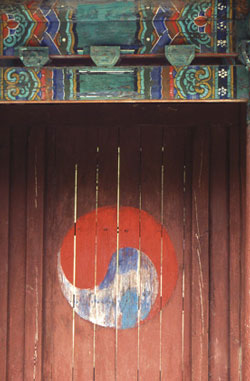 In old photographs of Kyongju, the ancient tumuli in the city’s heart of rose up from a great huddle of houses, the only grassy areas in sight. They had so long been part of the neighborhood that daily life probably went on without much thought that these were the last resting places of the ancient Shilla royalty.
In old photographs of Kyongju, the ancient tumuli in the city’s heart of rose up from a great huddle of houses, the only grassy areas in sight. They had so long been part of the neighborhood that daily life probably went on without much thought that these were the last resting places of the ancient Shilla royalty.
Today the houses are gone, and Tumuli Park is a vast and rolling expanse of grass-carpeted mounds, artfully accented with trees, a pond and winding walkways. Of the 23 mounds in the park, and many others scattered all around the environs of this ancient capital, the positive identity of the personages buried within is known for some and surmised for others. An excavated tomb which is completely unidentifiable, however, is usually named for the most distinctive find among its burial goods.
Ch’onmach’ong, the 6th-century Heavenly Horse Tomb, was named for a unique and beautiful birch bark saddle guard, painted with a flying white horse, one of the 10,000 relics unearthed from it. This mound has been opened to the public, with the stone- and earth-heaped burial chamber exposed in cross-section and exhibited behind glass. The kind and quality of the finds clearly indicate that this mound was the burial place of a king, although which one is unknown.
As Korea’s capital of culture, Kyongju could be likened to Japan’s Kyoto or Italy’s Florence. The difference is, however, that in Kyongju very little of the ancient architecture remains, forcing us to bring our imaginations into play as we stroll the old sites, take in the archeological relics and hear the legends.
The oldest secular structure remaining from Shilla times stands alone in a vast open area. Ch’omsong-dae, a bottle-shaped tower standing some nine meters tall, was an observatory built by seventh-century Queen Son-dok, the first woman to ascend to rule on the Korean peninsula, and one of the three queens among Shilla’s 56 rulers. Poetically named “Place Nearer the Stars,” this spot was then just a short walk through the trees from the one-time Palace of the Crescent Moon. There court astronomers perused the heavens, making ink drawings of star positions, and interpreting the signs which would guide the destiny of the land.
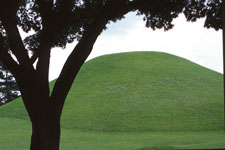 Another of today’s national treasures was also built during the reign of this revered queen, which followed the widespread acceptance of Buddhism. On the grounds of the temple Punhwang-sa stand the remains of the oldest datable pagoda in Korea. Of the original seven or nine stories, only three remain, but enough to indicate that it was likely one of the largest as well. Some of the contents of the relic box discovered within appeared to have belonged to a royal lady, perhaps even the queen herself.
Another of today’s national treasures was also built during the reign of this revered queen, which followed the widespread acceptance of Buddhism. On the grounds of the temple Punhwang-sa stand the remains of the oldest datable pagoda in Korea. Of the original seven or nine stories, only three remain, but enough to indicate that it was likely one of the largest as well. Some of the contents of the relic box discovered within appeared to have belonged to a royal lady, perhaps even the queen herself.
In the year 674, in celebration of his unification of the Three Kingdoms under the Shilla name and rule, the great King Munmu created the pleasure pavilions and gardens of Wolji, Pond of the Moon. Styled after a beloved Chinese Taoist mountain scene, the site was lavishly landscaped with exotic plants and populated with a great variety of waterfowl and animals.
Once again we must rally our imaginations, for when the kingdom fell several centuries later, Wolji was the site of Shilla’s formal surrender. Little by little, thereafter, it fell into ruin, and began to be known instead as the Pond of Geese and Ducks, or Anapji. Gazing at the reflection of a restored pavilion at water’s edge, we recall that 33,000 utilitarian artifacts were dredged up from the silt at the pond’s bottom, a great many of which are on display in their own dedicated hall at the fine National Museum nearby.
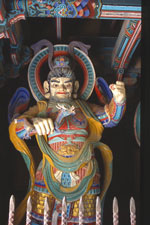 We head out of the city to see what is deemed the number one historical site of not only Kyongju but of all Korea: Pulguk-sa, the Temple of Buddha’s Country, where the priests and monks carry on the ancient tradition of praying for the peace of the country. A small temple had existed in this place already in the early 6th century, but was rebuilt in the mid-8th century on a grand scale by an eminent Shilla court minister, Kim Tae-song. That stunning complex of buildings was burned down by daimyo Toyotomi Hideyoshi’s soldiers in the 16th-century Japanese invasion, and during the following centuries it was only partially rebuilt. In 1973 it was finally restored to the brilliant and authentic visage we can see today, earning it a UNESCO World Heritage designation.
We head out of the city to see what is deemed the number one historical site of not only Kyongju but of all Korea: Pulguk-sa, the Temple of Buddha’s Country, where the priests and monks carry on the ancient tradition of praying for the peace of the country. A small temple had existed in this place already in the early 6th century, but was rebuilt in the mid-8th century on a grand scale by an eminent Shilla court minister, Kim Tae-song. That stunning complex of buildings was burned down by daimyo Toyotomi Hideyoshi’s soldiers in the 16th-century Japanese invasion, and during the following centuries it was only partially rebuilt. In 1973 it was finally restored to the brilliant and authentic visage we can see today, earning it a UNESCO World Heritage designation.
As colorful as these facades is the tale which surrounds minister-builder Kim. Grateful to his wealthy, noble parents, he built Pulguk-sa in their honor. But he clearly remembered his previous incarnation as the son of impoverished villagers, impelling him to not only return to that village to find his still-surviving widowed mother and bring her to live in his family’s luxurious household in Kyongju, but also to construct the Sokkuram Buddha Hermitage in tribute to those parents in his former life. A true masterpiece of Shilla aesthetics, this great Shakyamuni Buddha is seated within a domed cave-like pavilion, set on a ridge on the mountain Tohamsan, an hour’s hike or ten minutes’ ride up from Pulguk-sa.
 As for Minister Kim, sadly he passed away before he could see his formidable projects brought to completion. He is believed to be buried not far from Pulguk-sa, in one of the few square tomb mounds ever found in the Kyongju area. He is one small part of the amazing story of the Shilla Kingdom and of Kyongju. Through recorded deeds such as his, through the many legends and countless archeological remains in and around Kyongju, we can glimpse the glorious past and begin to understand the noble civilization that once was Shilla.
As for Minister Kim, sadly he passed away before he could see his formidable projects brought to completion. He is believed to be buried not far from Pulguk-sa, in one of the few square tomb mounds ever found in the Kyongju area. He is one small part of the amazing story of the Shilla Kingdom and of Kyongju. Through recorded deeds such as his, through the many legends and countless archeological remains in and around Kyongju, we can glimpse the glorious past and begin to understand the noble civilization that once was Shilla.
GETTING THERE
Korean Air and Northwest Airlines both offer daily flights from Narita to Pusan. Throughout the day a bus departs hourly from directly in front of Pusan’s Kimhae International Airport terminal for Kyongju. The first bus departs at 8:30 a.m. and the last at 8:25 p.m., and the journey takes about 90 minutes.
***************************
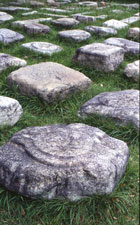 ON THE TRAIL OF BUDDHAS
ON THE TRAIL OF BUDDHAS
Once upon an ancient time, a Shilla king came to make ritual offerings to the monks at the dedication of a new temple. Among the humble holy men was one, particularly ugly and dressed in tatters, who asked the king if he might also take part. The king reluctantly agreed, but relegated the unsightly fellow to the back of the group.
Following the ceremony, the king singled him out and demanded, “Monk! Where do you live?”
“Your highness,” the monk replied, “My home is at Lute Rock on Namsan.”
The king barked with scorn, “You may go now, but don’t you dare tell a soul that one such as yourself was allowed to participate in a ceremony with the King!”
The monk laughed and replied, “You may go now too, but don’t you dare tell a soul that you gave offerings to a living incarnation of the Shakyamuni Buddha!”
With that, the monk leapt onto a passing cloud and returned to his mountain home. Gasping with shame, the king ordered his ministers to Namsan to find the monk but, alas, all they found were his alms bowl and staff he had left beside Lute Rock before disappearing into it. In heartfelt apology to the Buddha, the king built two great temples of worship near the site.
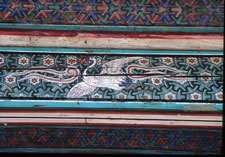 The legends of Shilla are said to be more numerous than the seeds of a pomegranate, and one could say the same of the sacred sites on Namsan. This “South Mountain” with a height of 494 meters, stands at the very edge of Kyongju.
The legends of Shilla are said to be more numerous than the seeds of a pomegranate, and one could say the same of the sacred sites on Namsan. This “South Mountain” with a height of 494 meters, stands at the very edge of Kyongju.
It has been named a UNESCO World Heritage Site, for its rugged peaks are laced with relic-strewn valleys. There are more than 100 former temple sites and dozens of stone pagodas, once erected to honor the deities who were thought to make Namsan their earthly home.
Fervent Buddhist believers—apparently artists among them—came here to pray, inspired by this heaven in nature. We retrace their footsteps from valley to valley, searching for sacred images carved in stone they left behind well over a thousand years ago.
Some unknown treasures have most certainly been spirited away during the ensuing centuries, while others have been moved to the protection of the National Museum in the city. However, many still stand on the mountain, beneath the sky, as though in a museum without walls.
Along the foothills, a few sites are so easily accessible that even local bus tours include them in their itineraries. But there are far more of them, reachable only on foot in Namsan’s deeper valleys, waiting to reveal themselves to the intrepid visitor.
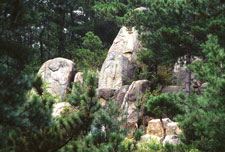 The Namsan Skyway, a rough hikers’ road, snakes its way up and across the mountain ridges, making many of the valleys more easily accessible also from their upper ends. We clamber up and down rocky trails, pick our way over gnarled tree roots, cross shallow rushing streams and work up a bit of a sweat.
The Namsan Skyway, a rough hikers’ road, snakes its way up and across the mountain ridges, making many of the valleys more easily accessible also from their upper ends. We clamber up and down rocky trails, pick our way over gnarled tree roots, cross shallow rushing streams and work up a bit of a sweat.
It is truly thrilling, after some struggle and exertion, to suddenly come upon one, then another, of these impressive spiritual artifacts. A few of the Buddhas and bodhisattvas are free-standing, sculpted in-the-round, while others are depicted in high or low relief on massive granite boulders and cliffs.
At last, when we stumble down to the foot of the mountain, with thighs quaking and knees shaking, we feel exhilarated by our rewarding explorations.
We’ll never forget there once was a time when believers might climb a wild mountain and devote months to carving an image of faith on a sheer cliff with barely a toehold…and there once was a time when Buddhas could be seen walking the earth—and even flying on clouds.




